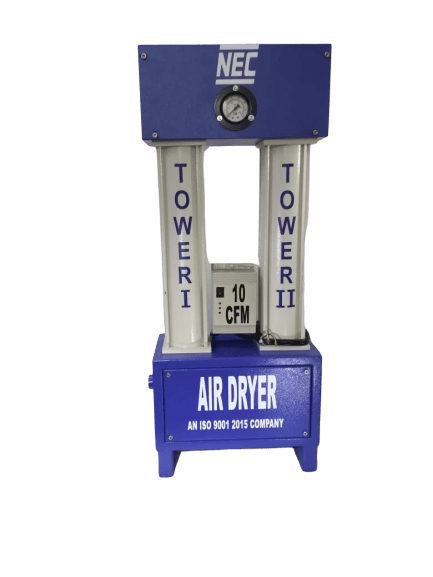Air Dryers
Heatless Air Dryer


Product Details
NEC Compact Desiccant type Heatless Air Dryers remove the moisture to a level of 80 ppm(w) by using pressure swing adsorption technology. The wet air enters into one desiccant tower and gets dried by the high performance desiccant adsorbent. The dry air passes through inbuilt filters and check valves to the utility. A portion of dry air (depending on the operating pressure and required dew point temperature) passes through an orifice into the other saturated tower at near atmospheric pressure, liberates the entrapped moisture in the desiccant to the atmosphere and regenerates it for the next drying cycle. A reliable electronic timer controls the cycle and valve operations effectively thereby ensures continuous dry air output to the utility.
Compressed air dryers are special types of filter systems that are specifically designed to remove the water that is inherent in compressed air. The process of compressing air raises its temperature and concentrates atmospheric contaminants, primarily water vapor. Consequently, the compressed air is generally at an elevated temperature and 100% relative humidity. As the compressed air cools, water vapor condenses into the tank(s), pipes, hoses and tools that are downstream from the compressor.
Excessive liquid and condensing water in the air stream can be extremely damaging to equipment, tools and processes that rely on compressed air. The water can cause corrosion in the tank(s) and piping, wash out lubricating oils from pneumatic tools, emulsify with the grease used in cylinders, clump blasting media and fog painted surfaces. Therefore, it is desirable to remove condensing moisture from the air stream to prevent damage to equipment, air tools and processes. The function of removing this unwanted water is the purview of the compressed air dryer.
There are various types of compressed air dryers. These dryers generally fall into two different categories, Primary and Secondary. Their performance characteristics are typically defined by flow rate in Standard Cubic Feet per Minute (SCFM) and dew point expressed as a temperature, (sometimes referred to as Pressure Dew Point.)
Applications:
Water contamination is an inherent byproduct of compressing atmospheric air. Because of this phenomenon, compressed air systems usually benefit from the addition of a compressed air dryer located on the output of the air compressor and/or at various locations throughout the distribution system. In most cases, the output of the compressor is processed through a primary dryer or system dryer. In cases where higher quality air is required the output of the primary dryer is further processed through a secondary dryer or polishing dryer.
Coalescing filters:
Coalescing filters aren’t actually filters, rather they operate more as a consolidation element. The idea behind these devices is that the compressed air is forced through gaps or porosity within an otherwise solid .
These gaps and/or porosity are microscopic and small enough that water vapor wets to the internal surfaces. The liquid water that forms during the wetting process is forced through the media and drips down into a trap. The dry air travels up to and out of the discharge port. There are two basic types of coalescing elements. The first type utilizes a cast material that is dominated with an internal microscopic lattice. The air is forced to flow through the lattice which, in turn, allows the water vapor to wet to the internal surfaces. The second type is generally referred to as a stacked plate element. In this case, fine discs are stacked with microscopic gaps between them. The air is forced to flow through the gaps which, in turn, allows the water vapor to wet to the internal surfaces.
In principle, a coalescing filter is an ideal way to separate water from the compressed air stream. Practically speaking, this is not the case. Coalescing elements are extremely sensitive to oil and particulate contamination and therefore would be better placed as a second stage dryer. However, the dew point performance of a coalescing filter places it in the primary category of compressed air dryers. In order to use coalescing filters as primary dryers, they are typically set-up in pairs. The first filter has an element with larger gaps that are designed to remove oil from the stream. The second filter uses a finer element that is intended to remove water vapor. Because of the sensitivity of the elements, coalescing filters are not particularly common. One area where these filters have found acceptance is with dental compressors. The way that dental compressors are designed and used makes a two-stage coalescing filter an almost ideal solution for water contamination in these systems.